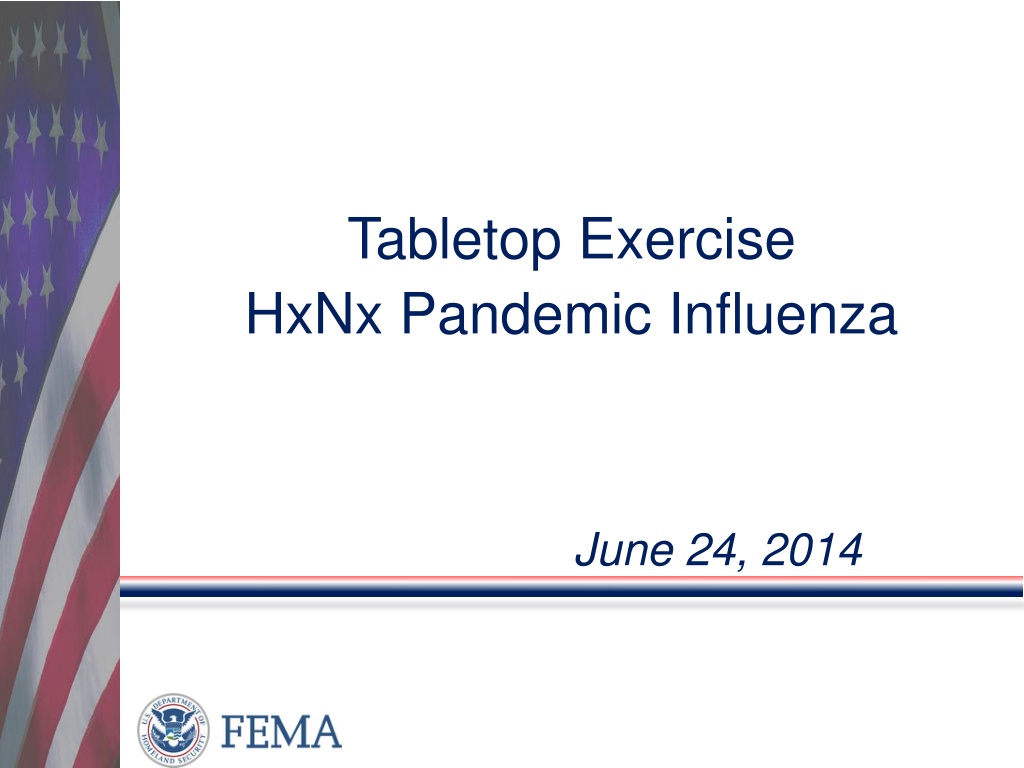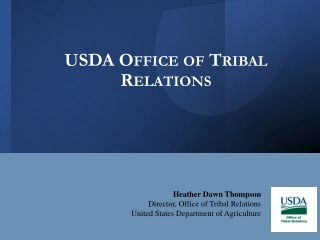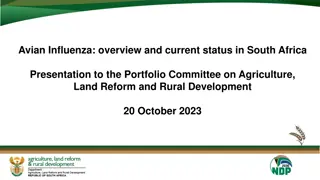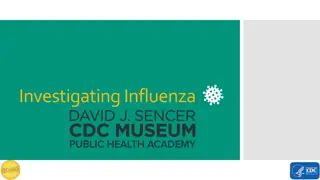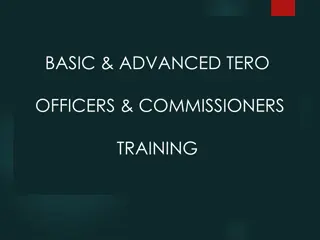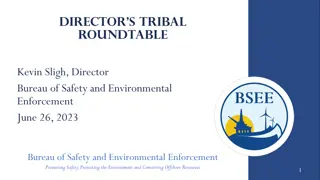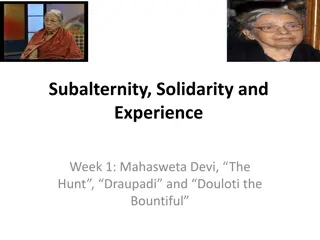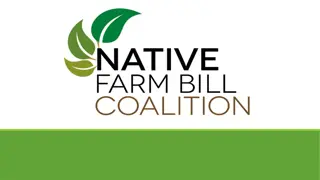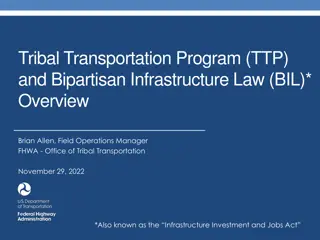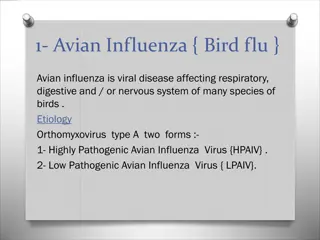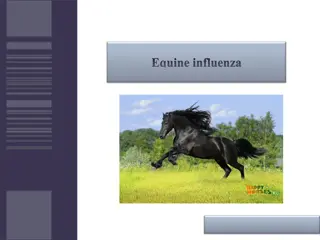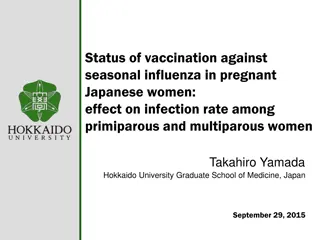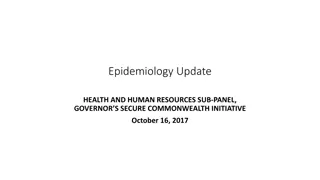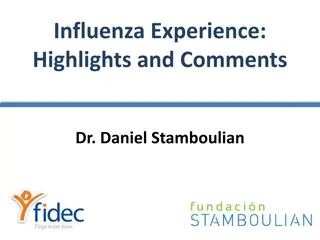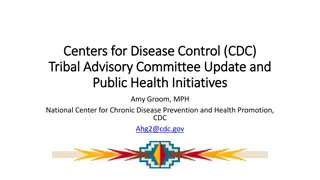Tribal Organization Response to HxNx Pandemic Influenza
This tabletop exercise focuses on the role of tribal organizations in responding to severe HxNx pandemic influenza scenarios, emphasizing interdisciplinary coordination at local, tribal, state, and regional levels. It addresses core capabilities for prevention, protection, mitigation, response, and recovery, aligning with PPD-8/National Preparedness Goal guidelines. The exercise also highlights the importance of infrastructure systems, mass care services, and situational assessment in the response and recovery phases.
Download Presentation

Please find below an Image/Link to download the presentation.
The content on the website is provided AS IS for your information and personal use only. It may not be sold, licensed, or shared on other websites without obtaining consent from the author.If you encounter any issues during the download, it is possible that the publisher has removed the file from their server.
You are allowed to download the files provided on this website for personal or commercial use, subject to the condition that they are used lawfully. All files are the property of their respective owners.
The content on the website is provided AS IS for your information and personal use only. It may not be sold, licensed, or shared on other websites without obtaining consent from the author.
E N D
Presentation Transcript
Tabletop Exercise HxNx Pandemic Influenza June 24, 2014
Scope Focus on the role of your tribal organization(s) in response to potential consequences of a severe HxNx pandemic influenza, as well as the interdisciplinary and interagency coordination both at the local, tribal, state, and regional level. Virtual Tabletop Exercise (VTTX) 2 2
Core Capabilities PPD-8/National Preparedness Goal PPD-8 calls for development and maintenance of a National Preparedness Goal defining the core capabilities necessary to prepare for the specific types of incidents posing the greatest risk to the security of the Nation States and urban areas use capabilities-based planning to identify a baseline assessment of their homeland security efforts by comparing their current capabilities against the Core Capabilities Core capabilities are essential for the execution of each of the five mission areas: Prevention Protection Mitigation Response Recovery Virtual Tabletop Exercise (VTTX) 3 3
Core Capabilities All Mission Areas: Planning - Conduct a systematic process engaging the whole community as appropriate in the development of executable strategic, operational, and/or community-based approaches to meet defined objectives. Public Information and Warning - Deliver coordinated, prompt, reliable, and actionable information to the whole community through the use of clear, consistent, accessible, and culturally and linguistically appropriate methods to effectively relay information regarding any threat or hazard and, as appropriate, the actions being taken and the assistance being made available. Operational Coordination - Establish and maintain a unified and coordinated operational structure and process that appropriately integrates all critical stakeholders and supports the execution of core capabilities. Virtual Tabletop Exercise (VTTX) 4 4
Core Capabilities Response: Infrastructure Systems - Stabilize critical infrastructure functions, minimize health and safety threats, and efficiently restore and revitalize systems and services to support a viable, resilient community. Mass Care Services - Provide life-sustaining services to the affected population with a focus on hydration, feeding, and sheltering to those who have the most need, as well as support for reunifying families. Situational Assessment - Provide all decision makers with decision-relevant information regarding the nature and extent of the hazard, any cascading effects, and the status of the response. Virtual Tabletop Exercise (VTTX) 5 5
Core Capabilities Recovery: Economic Recovery - Return economic and business activities (including food and agriculture) to a healthy state and develop new business and employment opportunities that result in a sustainable and economically viable community. Health and Social Services - Restore and improve health and social services networks to promote the resilience, independence, health (including behavioral health), and well-being of the whole community. Virtual Tabletop Exercise (VTTX) 6 6
Pandemic HxNx Influenza Background
Background/History on the Threat Influenza viruses, especially highly pathogenic avian influenza like H5N1, are among the most urgent global infectious disease threats. The occurrence of pandemics in 1918, 1957, 1968, and 2009 show that pandemics are inevitable, yet unpredictable events. The 2009 H1N1 pandemic occurred against a backdrop of ongoing pandemic planning efforts by governments and organizations throughout the world, which included a substantial amount of capacity building and pandemic response plan development. In fact, many of these activities were initiated because of the recognized potential for a highly pathogenic avian influenza virus (H5N1) to eventually develop the capability for sustained human-to-human transmission that could cause a severe pandemic. Virtual Tabletop Exercise (VTTX) 8 8
Background/History on the Threat As of August 2014, the World Health Organization (WHO) has reported 664 confirmed cases of HxNx infection, and since 2003, nearly 60% of those infections have been fatal. Although the imminent threat of the 2009 H1N1 influenza virus has subsided, influenza viruses with pandemic potential, including H5N1, H7N9, and H3N2v, continue to circulate across the globe. As a result, the threat of a pandemic caused by more pathogenic strains of influenza remains very significant. In fact, the threat of a more severe pandemic caused by HxNx or another highly pathogenic strain of influenza is no less than before the 2009 pandemic. CDC continues to maintain situational awareness of influenza so that the United States and other countries can be prepared to respond and intervene when a novel influenza virus is detected. Virtual Tabletop Exercise (VTTX) 9 9
World Health Organization (WHO) Phases Pandemic Influenza In response to lessons learned from the 2009 H1N1 pandemic, WHO revised the pandemic phases. The phases, which are based on virological, epidemiological, and clinical data, are to be used for describing the spread of a new influenza subtype, taking into account the disease it causes around the world. http://www.who.int/influenza/preparedness/pandemic/influenza_risk_management/en/ Virtual Tabletop Exercise (VTTX) 10 10
Module 1: Scenario Possible Novel Influenza A Virus in the United States Alert phase: This is the phase when influenza caused by a new virus has been identified in humans. Increased vigilance and careful risk assessment, at local, national and global levels, are characteristic of this phase. If the risk assessments indicate that the new virus is not developing into a pandemic strain, a de-escalation of activities towards those in the interpandemic phase (the period between influenza pandemics) may occur. Virtual Tabletop Exercise (VTTX) 12 12
Key Issues The patients have recently returned from an overseas trip with ILI Several of the conference attendees are showing signs of influenza- like illness (ILI), such as coughing, sneezing, fever, and lack of energy One patient is showing rapid progression of illness with severe symptoms. Two family members now show mild influenza like illness symptoms The middle school reports several cases of ILI from students HxNx case confirmed in the U.S. CDC EOC is activated Virtual Tabletop Exercise (VTTX) 13 13
Discussion Questions - Preparedness 1. What preparedness actions has your tribal nation taken to prepare for a pandemic influenza response? 2. What information would you need to provide to your partners or stakeholders on the steps they can take to quickly prepare for a severe pandemic? 3. What entities will you be coordinating with at this point and who may be reaching out to you for questions and assistance? 4. What types of guidance will you need and where do you expect that to come from? How will you share the information with your tribal community? How/what are you doing to ensure that specific at-risk and vulnerable populations are reached? 5. How will you prevent illness in your staff and the people you are responsible for? Operationally, do you have the staff and resources available to respond for a severe pandemic influenza? If not, how would you obtain these resources? Virtual Tabletop Exercise (VTTX) 14 14
Module 2: Scenario Widespread cases of the HxNx virus in the United States Pandemic phase: This is the period of global spread of human influenza caused by a new virus. Movement between the interpandemic, alert and pandemic phases may occur quickly or gradually as indicated by the global risk assessment, principally based on virological, epidemiological and clinical data. Virtual Tabletop Exercise (VTTX) 16 16
Key Issues Public Health Emergency is declared in US Community mitigation, such as school closures, measures are considered Worker Safety (e.g., hospital workers, teachers) is threatened Possible high rate of employee absenteeism and disruption of resources/services (e.g., healthcare, power, food services) Potential for maximum capacity in hospitals Potential immediate shortage of vaccines. Plan for mass vaccination. Shortage of Anti-Viral Drugs Virtual Tabletop Exercise (VTTX) 17 17
Discussion Questions - Response 1. What actions are critical during an initial response level, and then at the peak of response level in your tribal community response plan? 2. What information about self-protection from pandemic influenza needs to be communicated to your tribal communities? What s your policy on the closure of public services/schools or businesses? (Consider authority and responsibilities, trigger points, duration of closure, plans to re-open, and social consequences of implementing school/business closures.) 3. Community mitigation measures (e.g., school closures, social distancing) will increase rates of absenteeism in workplaces. What measures would you take to ensure the continuity of your operations/services? Do you have leave policies (e.g., telework) to cope with business closings and at home childcare during a pandemic? Virtual Tabletop Exercise (VTTX) 18 18
Discussion Questions - Response 4. It is likely that medical needs of people will overwhelm existing healthcare capacities. What measures will you implement in the community to mitigate surge on the hospital systems (e.g., alternate care systems, health professional call centers, delivery of only essential healthcare services)? 5. Discuss capacity to deliver pandemic vaccine in your community. What are methods to rapidly administer the pandemic vaccination program that can be initiated and fully implemented once a decision has been made to distribute pandemic influenza vaccine? 6. What assistance/policy guidance would you need at this stage of response? Virtual Tabletop Exercise (VTTX) 19 19
Module 3: Extended Response/Recovery
Module 3 Situation Timeline Transition phase: As the assessed global risk reduces, de-escalation of global actions may occur, and reduction in response activities or movement towards recovery actions by countries may be appropriate, according to their own risk assessments. Virtual Tabletop Exercise (VTTX) 21 21
Key Issues This is a pandemic transition phase About 30% of your community population contracted the virus, and about 20% of cases have been fatal How are mass fatalities handled Vaccines and anti-viral medications are generally available, with spot shortages Virtual Tabletop Exercise (VTTX) 22 22
Discussion Questions - Extended Response/Recovery 1. When should the response shift into recovery operations? What actions are critical at this response level in your tribal community response plan? How would you prioritize the actions? What assistance or guidance would you need during the recovery stage? What steps need to take place in order to rebuild your tribal community, at least a level of normalcy comparable to pre-incident level, and improved levels? Would you have adequate supplies/equipment/personnel to rebuild your community/jurisdiction back to normalcy? Does your emergency operations plan provide for feedback procedures in order to record experiences from this response and integrate lessons learned? Who will lead the after action process and how do you track the progress? 2. 3. 4. Virtual Tabletop Exercise (VTTX) 23 23
Participant Questions Remember a Virus is only a day away from your door !!!!! Virtual Tabletop Exercise (VTTX) 25 25
